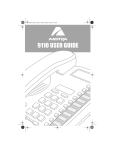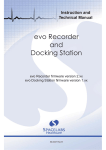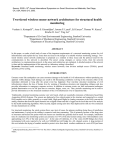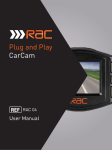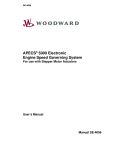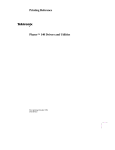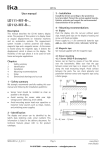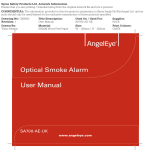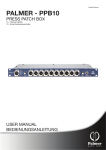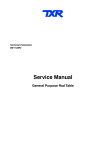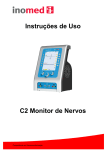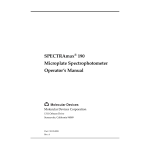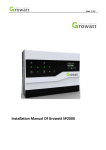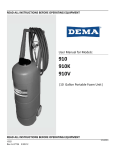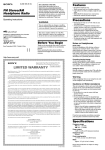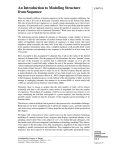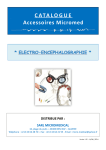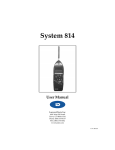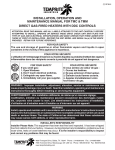Download - Frank`s Hospital Workshop
Transcript
Service Manual Lifecard CF and Lifecard 12 Firmware revision 7 Lifecard CF Service Manual 18-0583 Rev. C 1 This Page is intentionally Blank 2 18-0583 Rev.C Contents Page 1. PRODUCT OVERVIEW 1.1 INTRODUCTION 1.2 SpeciÞcation 7 7 9 1.2.1 Standard Recording Mode – ECG Inputs 1.2.2 Standard Recording Mode - Pacemaker Pulse Detection 10 1.2.3 Standard Recording Mode - Data Storage 10 1.2.4 User Interface 10 1.2.5 Power Requirements 11 1.2.6 Extended Recording Mode 11 1.2.7 Additional SpeciÞcations in 12-Lead Mode 12 1.2.8 Physical and Environmental 12 1.2.9 Electro-Magnetic Compatibility 13 2. SAFETY AND REGULATORY 9 15 2.1 Intended Use of Equipment 2.2 Safety ClassiÞcation 2.5 Explanation of Markings 15 15 17 LCF BUILT-IN TESTS 21 3. 3.1 3.2 3.3 3.4 3.5 3.6 Primary Built-in Tests Second Level Built-in Tests Third Level Built-in Tests User Level Tests Fault Protection While Recording Lifecard CF Menu Options 21 21 21 22 22 23 3.6.1 Main Menu Options 23 3.6.2 Setup Menu 25 3.7 Lifecard CF Sounds 3.8 Error and Warnings Displays 3.9 Decontamination 3.10 Patient Cable 3.11 Battery 3.12 Battery Check 3.13 Checking the Hardware & Software Revision 3.14 Compact Flashcard Lifecard CF Service Manual 28 29 32 33 34 34 34 35 3 4. Test Procedure 37 4.1 Checking the Patient Cable 37 4.2 LC12 Varios Yoke Assembly 4.3 Lifecard CF Check-out 37 39 5. Spares & Part Numbers 41 6. Assembly Views 43 6.1 Front Assembly - Front View - Complete 6.2 Front Assembly - Rear View 6.3 Intermediate Moulding 6.4 Circuit Board 6.5 Patient Cable Mounting with Clip 6.6 Short Patient Cable 6.7 Varios with 46-1123 Cable 46-1152 6.8 Varios Lead Parts 4 18-0583 Rev.C 43 44 45 46 48 49 50 51 ©Copyright 2010 Spacelabs Healthcare Ltd. 1 Harforde Court, John Tate Road, Hertford. SG13 7NW Lifecard CF Service Manual 5 This Page is intentionally Blank 6 18-0583 Rev.C 1. PRODUCT OVERVIEW 1.1 Introduction The Lifecard CF is a compact Holter Ambulatory ECG Recorder utilising a digital storage technique to store the ECG recording onto a Compact Flash (CF) card. The Lifecard CF provides continuous recording of 2 or 3 leads of ECG for up to 48 hours in standard mode and up to 7 days in extended mode. The Lifecard 12 option provides continuous recording of 12 leads of ECG for a period of 24 hours. The recorder has a built in display for you to monitor the ECG and pacing detection during hook-up. This enables you to verify the ECG quality before starting the recording. Menu options are selected using the 2 buttons on the front of the recorder unit. The Lifecard CF requires one AAA battery. The patient cables for the Lifecard CF are designed to prevent accidental disconnection from the recorder by the patient. The Patient Event button on the front of the recorder unit enables the patient to indicate symptomatic episodes in the recording for correlation with the patient diary. Pacemaker pulse detection may be enabled and disabled by the physician or cardiac technician. Recordings may be analysed using a Spacelabs Healthcare PathÞnder, Impresario, or Lifescreen Holter analysis system, if they have compatible hardware and software. (Lifescreen is incompatible with 12-lead recordings.) The Lifecard CF comprises two sections, the ‘Recorder Unit’ and the ‘Patient Cable Unit’. Lifecard CF Service Manual 7 LIFECARD CF RECORDER UNIT Recorder Unit Lifecard CF Display Yellow Button Menu Navigation and Patient Event Green Button Menu Selection and Patient Event Microphone Loudspeaker Patient Cable Unit Patient Cable Electrode Color Code label Belt Clip (long cables only) Slot for Neck Lanyard Attachment 8 18-0583 Rev.C Patient Cable Varios Active Yoke 1.2 Specification 1.2.1 Standard Recording Mode – ECG Inputs Channels 3, type BF applied part patient isolation types 2 or 3 channel 3 electrode, 2 4 electrode, 3 channel 6 electrode with detachable leadwires. Input impedance > 5Mȍ Ohms Input DC offset ± 300 mV, with saturation recovery circuit (3 seconds max) CMRR > 60 dB at 10Hz, > 80 dB at 50 Hz and above, 2 Vpp signal Dynamic range 10 mV Resolution 2.5ȝV Lifecard CF Service Manual 9 Calibration ± 5% Bandwidth 0.05 - 40 Hz (-3 dB) Sampling rate 1024 samples per second per channel Noise filter Linear phase Þlter effective from 60Hz to > 1MHz, 128 samples per second out put rate 1.2.2 Standard Recording Mode - Pacemaker Pulse Detection Sensitivity 7 mV nominal, channels 1 and 2 only Noise rejection > 50 mVpp for sinusoids up to 200 Hz CMRR 2 V common mode spikes are rejected Refractory period 40 ms 1.2.3 Standard Recording Mode - Data Storage Media type Removable card, CompactFlash Association standard (Type 1) Data types Full disclosure ECG, with pacing and patient event markers. Recording Time and Date. Patient name and record number (PathÞnder systems), Encrypted patient record Þle (CardioNavigator). 8 second voice recording. Recorder serial number Capacity req 15 Mbytes per channel per 24 hours eg. a 48 hour three channel recording occupies 90 Mbytes 1.2.4 User Interface Type Text menus with audio cues and keys for up, down and select Languages English, German, French, Italian, Spanish, Danish and Polish languages also Hebrew patient ID support Clock Clock and calendar (to 2098), selectable 12/24 hour and US/European date formats. 13mm digit height for patient use 10 18-0583 Rev.C Basic features Pacing detection on/off, hook-up display, voice recording for patient identiÞcation Ancillary features Identify and delete unread recordings, warning/error screens for battery and memory card conditions Hook-up display Real time display of each channel, with 60 ȝV/30 ms resolution and pacing annotation Set-up options Time and date, language, display contrast, recorder identiÞcation 1.2.5 Power Requirements Disposable cell Single AAA alkaline (Duracell MN2400 or equivalent), two 24 hour recordings or one 48 hour recording Rechargable cell Single AAA nickel metal hydride (Ansmann 600 mAh or equivalent), one 24 hour recording per charge Battery check User is warned of poor battery condition before recording Clock battery Internal rechargeable cell, charged during re cording. The clock is maintained for > 3 months between recordings 1.2.6 Extended Recording Mode Channels 2 channel recording, with pacing detection Cable Types 2 channel 3 electrode or 2 channel 4 electrode Resolution 10ȝV Sampling Rate 256 samples per second per channel Compression 10ȝV maximum compression error when tested with MIT-BIH Arrhythmia and Compression databases Capacity required 90 Mbytes for dual channel 1 week Disposable Cell AAA alkaline (Duracell MN2400 or equivalent) for 1 week. User Interface Includes an audible alarm to alert the patient if an electrode becomes detached. Sense current is < 10 nA. Note: other specifications are the same as Standard Recording Mode. Lifecard CF Service Manual 11 1.2.7 Additional Specifications in 12-Lead Mode Channels Standard 12-lead, one neutral and nine active electrodes Cable types 10 electrode, deÞbrillation protected, IEC or AHA code Isolation DEFIBRILLATION-PROOF TYPE CF APPLIED PART Input impedance 10 Mohm Sampling rate 4096 samples per second per channel CMRR > 80dB per IEC and ANSI/AAMI methods Suppression Active neutral system (‘right leg drive’) Resolution 0.6ȝV Noise < 0.6ȝV RMS Pacing detection >2mV, 200ȝs to 5ms pulse in any electrode Capacity required 256 MByte card for 24 hour recording Battery An alkaline AAA cell is required for 24 hour recording Fault tolerance In the event of electrode detachment noise is suppressed, and the available leads are recorded (differential V leads only if R, L or F is detached) Note: other specifications are the same as Standard Recording Mode 1.2.8 Physical and Environmental Dimensions 96 x 57 x 17.5mm with patient cable Þtted Weight Recorder body 55g: patient load 130g including battery, card and typical patient cable User labelling Area provided is 52 x 15 mm Temperature 0 to 45°C operation, -20 to 65°C storage Humidity Operation or storage 5% to 95%, non-condensing Pressure Operation or storage air pressure 700 - 1060 mbar Shock 1 m drop 12 18-0583 Rev.C 1.2.9 Electro-Magnetic Compatibility General Complies with EN60601-1-2:1993 and ANSI/ AAMI EC38:1998 ESD (1) 4 kV air and 2 kV contact discharges: no inter ruption in recorder function ESD (2) 8 kV air and 6 kV contact discharges: no damage to the recorder, recording resumes automatically in < 10 s Radiated emissions CISPR 11:1997, EN55011:1998 Group 1 Class B Radiated immunity 3 V/m 26 MHz - 1 GHz, 80% AM modulated at 5 Hz. Keyed carrier immunity to EN50082:1996 This equipment has been tested and found to comply with the limits for a class B computing device in accordance with the speciÞcations in Subpart J of Part 15 of FCC Rules, which are designed to provide reasonable protection against interference to radio and television reception. This equipment generates and uses radio frequency energy and if not installed and used in accordance with the instructions it may cause interference. However, there is no guarantee that interference will not occur in a particular installation. If this equipment does cause interference to radio or television reception, which can be determined by turning the equipment off or on, the user is encouraged to try to correct the interference by one or more of the following measures: • Reorient the receiving antenna • Relocate the equipment with respect to the receiver • Move the equipment away from the receiver If necessary, the user should consult Spacelabs Healthcare or an experienced radio/television technician for additional suggestions. The user may Þnd the following booklet prepared by the Federal Communications Commission helpful: “How to Identify and Resolve Radio-TV Interference Problems” This booklet is available from the U.S. Government Printing OfÞce, Washington, DC 20402, Stock No. 004-000-00345-4. Lifecard CF Service Manual 13 This Page is intentionally Blank 14 18-0583 Rev.C 2. SAFETY AND REGULATORY 2.1 Intended Use of Equipment The Lifecard CF Holter recorder is to be used for the non-invasive ambulatory recording of two or three channel electrocardiograms on a standard commercial compact ßash card. The Lifecard 12 option is to be used for the non-invasive ambulatory recording of 12-lead electrocardiograms on a standard commercial compact ßash card. The recorder allows data to be collected over a continuous period of up to 7 days whilst allowing the subject to perform most of their normal daily activities. The recordings can be analysed on compatible analysis systems from Spacelabs Healthcare. This device has been designed and supplied speciÞcally for the long term recording of electrocardiograms in ambulatory patients using standard Holter monitoring techniques. It shall not be used for any other purposes. The device shall be operated only be suitably competent personnel trained in the use and procedures of Holter electrocardiography for diagnostic purposes. The Lifecard CF comprises two sections; the ‘Recorder Unit’ and the ‘Patient Cable Unit’. 2.2 Safety Classification This device has been designed in accordance with EN60601 - 1 , “Medical electrical equipment, Part 1: General requirements for safety”, as follows: 1. EQUIPMENT with an INTERNAL ELECTRICAL POWER SOURCE. The equipment is designed to be battery operated only. Under NO circumstances shall a mains powered battery eliminator or any other external power source be used with the equipment. Lifecard CF Service Manual 15 2. EQUIPMENT having a TYPE BF APPLIED PART. or 3. EQUIPMENT having a TYPE CF APPLIED PART if so marked. 4. IPX4 EQUIPMENT protected against the ingress of splashing water, if so marked. Otherwise, ORDINARY EQUIPMENT, without protection against ingress of liquid. 5. Not suitable for use in the presence of a ßammable anesthetic mixture with air or with oxygen or nitrous oxide, or ßammable cleaning agents. 6. Rated for CONTINUOUS OPERATION. 7. EQUIPMENT with an APPLIED PART, speciÞcally designed for application where a CONDUCTIVE CONNECTION is made to the PATIENT, but not directly to the heart. According to ANSI/AAMI EC38:1998.Lifecard CF is Type 1 ambulatory ECG device. 2.3 Adjustment, replacement of parts, maintenance and repair The device requires no routine adjustments to maintain its operation. The device contains no user serviceable parts. It shall be serviced only by Spacelabs Healthcare or by an agent accredited by them to service device of this type. Unauthorised repairs or dismantling of the device will invalidate the guarantee. 2.4 Defects and abnormal stresses For continued safety the device must not be maltreated, used outside its speciÞed operation conditions, or stored outside its speciÞed storage conditions. Lifecard CF contains protection against electrostatic discharge, but there is no protection against deÞbrillators. To avoid damage the device should be removed before deÞbrillating. The Varios active yoke and 46-1123 / 46-1127 patient cables have deÞbrillator protection. (The protection is a combination of the cable and the yoke). 16 18-0583 Rev.C Whenever it is likely that protection has been impaired, the device shall be made inoperative and secured against any unintended operation. The protection is likely to be impaired if, for example, the device shows visible damage. a) shows visible damage b) fails to perform the intended measurements c) has been subjected to prolonged storage under unfavorable conditions d) has been subjected to severe transport stresses e) the device has been connected to a patient during deÞbrillation. 2.5 Explanation of Markings CE Mark Date of Manufacture Manufacturer Consult Documents This symbol means you should read the accompanying documents EQUIPMENT having a TYPE BF APPLIED PART EQUIPMENT having a DEFIBRILLATION-PROOF TYPE CF APPLIED PART Battery Eject symbol Lifecard CF Service Manual 17 Protected against ingress of splashing water when the patient cable is Þtted. AECG- Type 1 ambulatory ECG device according to ANSI/ AAMI EC38:1998 This product must be sent to separate collection facilities for recovery and recycling 12 LEAD 9 2.6 Compatible with Varios Active Yoke & 10-electrode cable Warranty Subject to the conditions set out below, Spacelabs Healthcare (“The Company”) warrants that its Products will be free from defects in material and workmanship for a period of 12 months from delivery. This warranty is given by The Company subject to the following conditions: 18 1. The Company shall be under no liability in respect of any defect arising from fair wear and tear, willful damage, negligence, abnormal working conditions, failure to follow instructions (whether oral or in writing), misuse, improper installation or alteration or repair of the Products without The Company’s approval. 2. The above warranty does not extend to parts, materials or devices not manufactured by The Company, in respect of which the Customer shall only be entitled to the beneÞt of any such warranty or guarantee as is given by the manufacturer to The Company. 3. Subject as expressly provided here, all warranties, conditions or other terms implied by statute or common law are excluded to the fullest extent permitted by law. 4. Any claim by the Customer which is based on any defect in material or workmanship of the Products shall be notiÞed to The Company immediately after discovery of the defect. If the Customer does not notify The Company accordingly, the Customer shall not be entitled to reject the Products and The Company shall have no liability for such defect. 5. Where any valid claim in respect of any of the Products which is based on any defect in the material or workmanship of the Products is notiÞed to The Company, The Company shall be entitled to replace or repair (at The Company’s sole discretion, either at the Customer’s premises or at The Company’s premises in the United Kingdom) the Products (or part in question) but The Company shall have no further liability to the Customer. 18-0583 Rev.C 6. The Company shall not be liable to the Customer by reason of any representation, or implied warranty, condition or other term, or any duty at common law, or for any consequential loss or damage (whether for loss of proÞt or otherwise), costs, expenses or other claims for consequential compensation whatsoever arising out of or in connection with any act or omission of The Company relating to the manufacture or supply of the Products or use by the Customer. 7. Spacelabs Healthcare recommends the use only of approved accessories and parts. The use of third party accessories may result in damage to recordings or equipment, and may invalidate your warranty. 2.7 Contact Details Spacelabs Healthcare Ltd 1 Harforde Court John Tate Road Hertford SG13 7NW United Kingdom Spacelabs Healthcare Inc. 5150 220th Ave. SE Issaquah, WA 98029 USA Tel: +44 (0)1992 507700 Fax: +44 (0)1992 501213 Tel: +1 425 657 7200 Fax: +1 425 657 7212 Web site: www.spacelabshealthcare.com 2.7 Modifications For continued safety, the device shall not be subjected to any Unauthorised modiÞcations and must be used only for the purpose for which it was originally supplied. Lifecard CF Service Manual 19 20 18-0583 Rev.C 3. LCF BUILT-IN TESTS 3.1 Primary Built-in Tests When a battery is inserted the internal functions of the microcontroller are tested automatically. If any errors are found the recorder will start to beep loudly, before the patient cable is Þtted. The pattern of beeps indicates the cause of the problem. 3.2 Second Level Built-in Tests When the patient cable is Þtted the microcontroller applies further automatic tests before proceeding with normal operation. The integrity of the complete operating programme is tested at this point. If any errors are found the recorder will start to beep after the cable has been Þtted. The pattern of beeps again indicates the cause of the problem. 3.3 Third Level Built-in Tests Lastly, the microcontroller tests the remaining peripheral circuits, communicating any errors with a text message on the LCD. The following service screen codes are used: 0001 Oscillator/clock fault 0002 SRAM fault 0003 EEPROM data error (data includes the unit serial number, etc.) 0004 ADC operation fault 0005 ADC calibration fault 0006 ConÞguration fault 0007 LCD Voltage fault 0008 Varios Active Yoke EEPROM data error 012 (TIMI recorders only) Clock, EEPROM, SRAM or LCD Voltage fault. Lifecard CF Service Manual 21 3.4 User Level Tests Before commencing the recording the recorder checks all aspects that are under the user’s control, and will display warning or error messages as described in the user manual. Items checked include: • • • • • Battery voltage Loss of time and date since last use CF card needs conditioning CF card contents- have they been read out for analysis? Patient cable type If a recorder frequently requires the time and date to be entered or corrected, it should be returned for service. 3.5 Fault Protection While Recording During recording the recorder operation is supervised in various ways, to ensure that all recorded data is correct and the recording is as complete as possible: • • • • • • The battery level is continually monitored. Low battery shutdown is described in the user manual. If the LCD is found to be in the wrong state the recorder will re-load the display. Data written to the CF card includes error detection information which is checked before analysis. The recorder shuts down immediately if the cable is removed. If the patient cable is removed and then replaced, the recorder will continue after a countdown message. The analyser will display a corresponding blank period in the ECG. The 32768Hz crystal is monitored via a watchdog to ensure that it is operating correctly. Other transient faults can cause a short blank in the ECG while the recorder resets and restarts: • • • • 22 Intermittent power supply, due to contact corrosion, bad joints, or possibly severe shock. The recorder software running improperly (watchdog timer). Error messages from the CF card that cannot be resolved. Any other unexpected condition such as data errors due to large electrostatic discharge. 18-0583 Rev.C 3.6 Lifecard CF Menu Options The Lifecard displays are controlled by two buttons: • The yellow Ÿ Up and ź Down button is used to move up and down the menus, to highlight the menu option. You also use it to choose which channel is displayed on the monitor. • The green Ź Select button is used to select the highlighted option. 3.6.1 Main Menu Options Displays options for starting and setting up the recorder. 1. Lifecard CF Option If alternative operating modes are available on your recorder and you wish to use them, contact Spacelabs Healthcare Ltd. for the appropriate user manual. 2. Pacing option Use this option to select or deselect pacing detection. Lifecard CF Service Manual 23 3. Start... Option Select Start when you want to make a recording in Standard Recording Mode, up to 48 hours of 2 or 3 channel ECG, or 24 hours of 12-lead ECG. 4. Start Week ...Option Select Start Week when you want to make a recording in Extended Recording Mode, to record up to 7 days of continuous 2 channel ECG. 5. Recorder ID This is a name or number you have chosen for the recorder using an option in the Set Up menu. Your chosen ID will appear in the Main Menu and on PathÞnder reports. There is a space inside the recorder unit for you to affix a bar code or similar. 6. Set Up Option Select this option to conÞgure the recorder. 7. Language Option Select this to change the language displayed on the monitor. Keep pressing the green Ź Select button to switch between the languages until the correct one is displayed. 8. About option This option displays the Software Version number and Hardware Serial number. Pressing the green Ź Select button returns you to the Main Menu. 24 18-0583 Rev.C 3.6.2 1. Setup Menu Contrast Option Displays a bar indicating the current setting of the contrast. The display can be darkened or lightened by pressing the yellow Up or Down button. Press the green Select button to return to the Set Up Menu. 2. Time Adjustment Option This option enables you to select a 12 or 24 hour clock display. Use the yellow Ÿ Up or ź Down button to change the selection and then press the green Ź Select button to select it. Lifecard CF Service Manual 25 Adjust the hours by pressing the yellow Ÿ Up or ź Down button until the correct one is displayed, then press the green Ź Select button. This moves the highlight onto the minutes which you then adjust in the same way. Pressing the green Ź Select button again returns you to the Set Up Menu. 3. Date Adjustment Option This option enables you to select a European or American date format. Use the yellow Ÿ Up or ź Down button to change the selection and then press the green Ź Select button to select it. Adjust the date in the same way as you have adjusted the time. 4. Speech Recording On/Off Press the green Ź Select button to switch between the Speech Recording option being on or off. 26 18-0583 Rev.C 5. ID:Enabled/Disabled This option enables you to give the recorder a personalised name or number ID. Your chosen ID will appear in the Main Menu and on reports. To use this option, highlight the ID:Disabled line in the Set Up menu and press on the green Ź Select button. Press either of the yellow Ÿź buttons until ‘ID: enabled’ is displayed. Then press the green Ź Select button to enter your recorder ID. The Þrst character of the ID will be highlighted. Use the yellow Ÿ ź buttons to change the character as required and then press the green Ź Select to move the highlight onto the next character. You can enter a name or number up to 10 characters long. 6. Sounds On/Off Use the green Ź Select button to select or deselect the Lifecard sounds. Lifecard CF Service Manual 27 7. Service The recorder will remind you when the annual service is due. 3.7 Lifecard CF Sounds The Lifecard CF generates sounds to conÞrm your actions, or to inform you about the status of the recorder. 1. Click The ‘click’ sound is emitted whenever you press the yellow Ÿ Up or ź Down button. 2. OK ‘boing’ The ‘OK’ boing tells you that the recorder is functioning properly and also sounds whenever you press the green Ź Select button. The tone is a higher note than the ‘error’ tone. 3. Error tone The Error tone tells you that the recorder has identiÞed an error or warning condition. The tone is a lower note than the ‘OK’ boing. 4. 28 High Impedance or Lead Off Alarm 18-0583 Rev.C During an extended recording, if a lead becomes detached, the Lifecard will generate an alarm to warn the patient. The alarm is a ‘ding-dong’ tone lasting 15 seconds, and the clock display will be replaced by the LEAD OFF message, indicating which channel has been affected. Once the patient has replaced the lead, the clock display resumes. You can turn the sound off by selecting Sound Off in the set up menu. This does not affect the ‘Lead Off’ alarm. 3.8 Error and Warnings Displays 1. You will see this error message if you are trying to use Extended Recording Mode with a six electrode cable. Either select Start. . . for Standard Recording Mode or change the patient cable. 2. You are trying to use Standard Recording Mode with a two electrode cable. Either select Start Week for Extended Recording Mode or change the patient cable. 3. There may be a fault in the cable, or you may require a Þrmware upgrade to use this cable type. Lifecard CF Service Manual 29 4. If this error message is displayed, contact the Service Department at Spacelabs Healthcare Ltd. 5. This message is displayed if a patient loses a lead during an Extended Recording. The Lifecard will also generate an alarm which will consist of a series of ‘dingdong’ tones lasting 15 seconds. Once the patient has replaced the lead, the clock display resumes. 6. This warning is generated if you have selected Start Week... and the battery is partially discharged. 7 day recording needs a new alkaline battery. 7. You will see a warning of this format if you have selected Start Week.... and the capacity is too small to record 7 days. Select Continue only if the recording description meets or exceeds your requirements. 30 18-0583 Rev.C 8. This message appears if the card capacity and patient cable are not appropriate to provide a 24 hour recording. 9. The Lifecard has been closed without a Flashcard inserted. Reopen the recorder and insert the card. 10. The Flashcard has been inserted before being correctly initialised. Remove the card and initialise the card. 11. If the Flashcard contains a recording that has not previously been analysed, you have the option to delete it. Select the ‘DETAILS’ option - if the patient information is available, then the Patient screen is displayed. Otherwise the screen will display just the time that the recording was started. Lifecard CF Service Manual 31 12. If the recorder detects that the rechargeable clock battery has discharged since the last use, you must enter the time and date. 13. If this message is displayed before you start a recording, you should insert a new battery immediately. 3.9 Decontamination Before commencing any service or maintenance procedures, ensure the Lifecard CF recorder has been suitably decontaminated. Unless contamination with body ßuids is known or suspected, we recommend low-level disinfection. See the user instructions for further details on cleaning and disinfecting the recorder. In the case of severe contamination, the recorder may be beyond repair. Please contact Spacelabs Healthcare for further advice. 32 18-0583 Rev.C 3.10 Patient Cable Lifecard CF patient cables use screened lead-wires with tinsel conductors and an antimicrophonic barrier to provide strength, ßexibility and low noise. There is a choice of 7 patient cable units: • • • • • 4 electrode cable with belt clip 4 electrode cable, short, no belt clip 3 electrode cable with belt clip 3 electrode cable, short, no belt clip 6 electrode cable with belt clip and renewable lead wires (unscreened) • 10 electrode cable for Varios Active Yoke, AHA code • 10 electrode cable for Varios Active Yoke, IEC code Two electrode cables for single channel ECG are no longer offered. We recommend three electrode hook-up in long term applications. Cables with 4 electrodes provide two channels of ECG. The popper colour code, which is detailed on the cable, conforms to AHA (1985) recommendations. The short cable without belt clip is designed to maximise patient comfort when the recorder is worn under clothes. The 3 electrode scheme and popper colour code, as detailed on the cable label, is proprietary to Spacelabs Healthcare. The 6 electrode cable provides three channels of ECG from 6 electrodes. The individual lead wires are detachable and can be replaced with any DIN42802 connector lead wire, useful in situations requiring unusual hook-up or electrode terminations. The yoke is colour coded to AHA (1985) recommendations. The cable yoke/back unit forms a complete assembly and is not serviceable. In the case of failure, the complete assembly must be replaced. In the case of the 6 electrode cable, the individual lead wires may be replaced if broken. The 10 electrode cable is replaceable as a complete assembly by releasing the screw securing it to the Varios active yoke. The Active Yoke itself it not serviceable and must be returned to Spacelabs Healthcare for repair. Lifecard CF Service Manual 33 3.11 Battery Lifecard CF requires one AAA cell, either: Disposable cell Single AAA alkaline (Duracell MN2400 or equivalent), two 24 hour recordings or one 48 hour recording or in Extended Recording Modeup to 7 days, or in 12-lead mode 24 hours. Rechargeable cell Single AAA nickel metal hydride (Ansmann 600 mAh or equivalent), one 24 hour recording per charge, or in Extended Recording Mode up to 3 days. Not suitable for 12-lead recording 3.12 Battery Check The user is warned of poor battery condition before recording, when starting the recorder. Please refer to the detailed instructions, in this user manual. The real-time clock is maintained by an internal rechargeable lithium cell, charged during recording from the main battery. With a full charge, the clock is maintained for at least 3 months after the main battery is removed or exhausted. The clock cell is not replaceable by the user, and in the case of suspected failure the Lifecard CF should be returned to Spacelabs Healthcare for service. Dispose of used batteries carefully, using environmentally friendly methods wherever possible. 3.13 Checking the Hardware & Software Revision 1. Insert a battery and close the back cover. 2. Press the Yellow (DOWN) key to highlight the About menu option, then press the Green (SELECT) key. 3. The revision numbers are displayed on the LCD. 34 18-0583 Rev.C 3.14 Compact Flashcard The recorder uses a CF card (type 1) Compact Flashcard, non volatile memory card meeting the Compact Flash Association type 1 standard. A new ßashcard must be conditioned before Þrst-time use, which may be done by the user from a menu option in the Spacelabs Healthcare Ltd. Holter analyser. However, cards supplied by Spacelabs Healthcare are already conditioned. Full details are in the user instructions manual. If the card has not been supplied by Spacelabs Healthcare Ltd, ensure the type is exactly as listed in the Accessories section of this manual Other types may give short or unreadable recordings. Lifecard CF Service Manual 35 This Page is intentionally Blank 36 18-0583 Rev.C 4. Test Procedure 4.1 Checking the Patient Cable • • • • • • • Fit a battery and CF card to the Lifecard CF Connect the patient cable to the 9270 Tracker calibrator. ( For a 3 lead cable – Red to CH1+,Yellow to CH2-, Green to CH2+, and select Cal1, PACE 2.) If using another cable or source ensure that there is a unique signal in each channel. In the main menu, select Start…. Skip the voice recording Verify that the patients name has been written on the card. In the hook-up screen, scroll down the three channels and check signal and quality when the cable is gently ßexed to reveal any intermittent cable faults. Channel 2 has a negative pacing spike only. When all the leads have been checked, disconnect the Lifecard CF and calibrator. 4.2 LC12 Varios Yoke Assembly The Lifecard CF used to check these leads must have version V07.xx Þrmware. An Electromedicina ST-20 ECG Simulator is required, select Pacemakers/DVI, test signal. • Fit the battery and CF card to the Lifecard CF • Connect the patient cable to the ST-20 simulator: • • • • • • • • Connect the Lifecard CF to the Varios yoke Verify that the Lifecard CF shows the Lifecard 12 splashscreen In the main menu, select Pacing On In the main menu, select Start... Skip the voice recording Verify that the patients name has been written on the card. In the hook-up screen, scroll down through 9 leads, checking each one: All should have regular pacing markers (small vertical arrow with P). Lifecard CF Service Manual 37 • • • • 38 All should have baselines that settle in the central 1/3 of the screen. The expected signals are shown in the Þgure below. Checking leads I, II and III is not necessary. When all the leads have been checked, disconnect the Lifecard CF and ST-20 simulator. 18-0583 Rev.C 4.3 Lifecard CF Check-out Connect the 3 Lead Patient Cable to the 9270 Tracker Calibrator, Red to CH1+, Yellow to CH2-, Green to CH2+, and select Cal 1, PACE 2. If using another cable or source ensure that there is a unique signal in each channel. Fit a CF card, a AAA battery and the 3 Lead Patient Cable to the unit under test. Check that the speaker tone and display are normal. In the main menu ensure that PACING DET. Is ON, and then select START. Select RECORD and speak clearly into the microphone from a distance of approximately 150 mm. The recording is replayed automatically; check that the recording / replay is clear and audible. Select CONFIRM and then check the Channel 1, Channel 2 and Channel 3 hook-up displays (push the ‘down’ button twice). Using the 9270 calibrator, Channel 2 has a negative pacing spike only. Press the ‘select’ button to leave the hook-up display then select START NOW. Approximately 30 minutes after starting the recording press the Green button to mark a Patient Event in the recording. Wait for 1 minute and remove the Patient Cable. Wait for another minute before re-attaching the Patient Cable. After 30 seconds the Recording should continue. Leave the recording running for up to 24 hours. Remove the 3 Lead Patient Cable and eject the CF card, eject the AAA battery to check for jamming. Analyse the recording on PathÞnder or Lifescreen. Check for the Patient Event and recording break 30 minutes into the recording. Lifecard CF Service Manual 39 40 18-0583 Rev.C 5. Spares & Part Numbers Product Code Description 19-5000 Lithium Battery, Rechargeable 19-5044 LCF Speaker, 64 Ohms 19-5074 Microphone, Condenser 19-5075 Battery Contact, Positive 19-5077 LCD Display 19-7508 Screw PT 1.8 x 10mm, Philips 23-0223 Pocket Clip 23-0224 Mount 23-0226 Spring Pocket Clip 46-0037 Hinge Moulding 46-0043 Top Cover Moulding 46-0044 Intermediate Moulding 46-0045 Card Ejector Moulding 46-0046 Retainer Moulding, Up/Down 46-0047 Retainer Moulding, Select 46-0050 Switch Moulding, Up/Down 46-0051 Switch Moulding, Select 46-0056 PCB Insulator 46-0057 Internal Label 46-0059 Main Seal 46-0062 Top Cover Assembly 46-1570 LCF PCB Assembly, Exchange 46-0420 Mic Speaker 46-0421 Speaker Seal 46-0426 Acoustic Membrane 46-0462 Battery Contact, Negative 46-0493 Catch Moulding Printed 46-0551 Waterproof Lens 46-0418 3 Electrode Patient Cable with Clip 46-0480 3 Electrode Patient Cable, Short Lifecard CF Service Manual 41 42 46-0556 4 Electrode Patient Cable with Clip 46-0557 4 Electrode Patient Cable, Short 046-0031 6 Electrode Patient Cable with Clip 19-7509 6 Electrode Wire Lead Set 046-0523 7 Electrode Patient Cable with Clip 19-7510 7 Electrode Wire Lead Set 46-1152 LC12 Varios with 46-1123 Cable 46-1153 LC12 Varios with 46-1127 Cable 46-1122 LC12 US Patient Cable (Leads) 46-1123 LC12 EU Patient Cable (Leads) 46-1125 LC12 Varios Active Yoke (No Leads) 18-0583 Rev.C 6. Assembly Views 6.1 Front Assembly - Front View - Complete Lifecard CF Service Manual 43 6.2 44 Front Assembly - Rear View 18-0583 Rev.C 6.3 Intermediate Moulding Lifecard CF Service Manual 45 6.4 Circuit Board 46-0464 Batterry Contact, Negative 19-5075 Batterry Contact, Positive 19-5077 LCD Display 46-1570 LCF PCB Assembly 46-0421 Speaker Seal, LCF 19-5044 LCF Speaker, 64ohms 19-5074 Microphone, Condenser 46 18-0583 Rev.C Lifecard CF Service Manual 47 6.5 48 Patient Cable Mounting with Clip 18-0583 Rev.C 6.6 Short Patient Cable Lifecard CF Service Manual 49 6.7 50 Varios with 46-1123 Cable 46-1152 18-0583 Rev.C 6.8 Varios Lead Parts Lifecard CF Service Manual 51 52 18-0583 Rev.C




















































